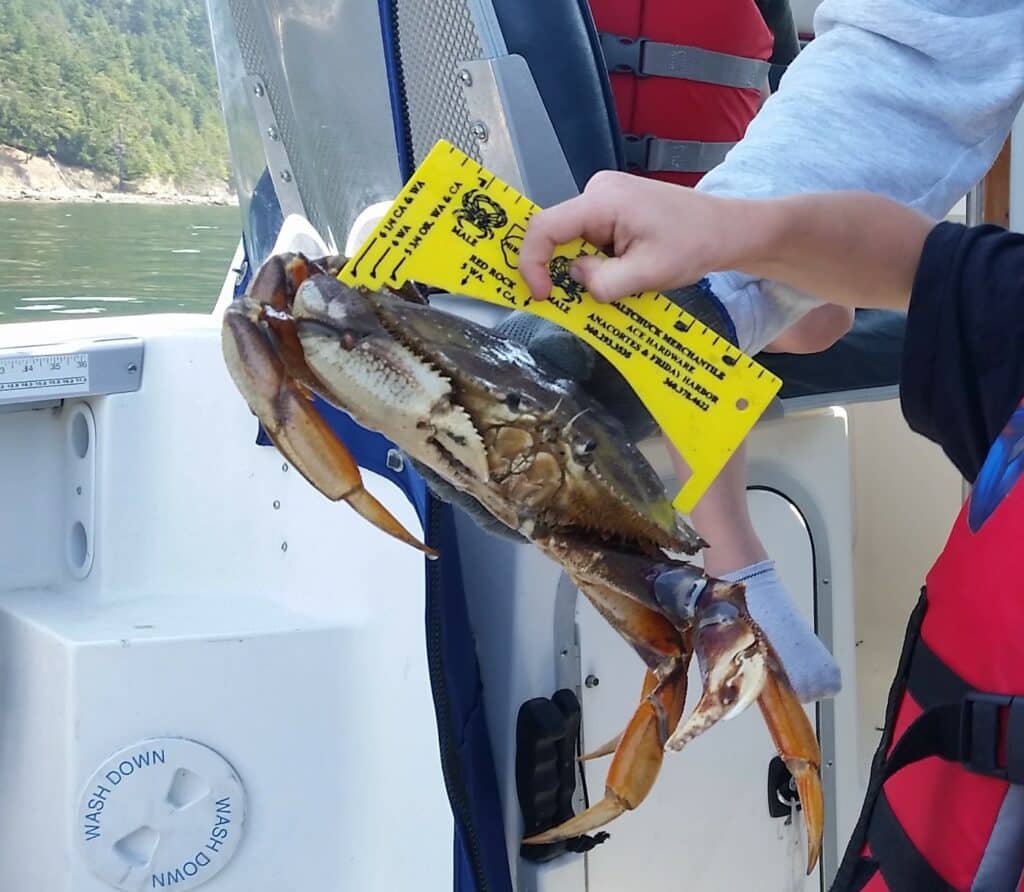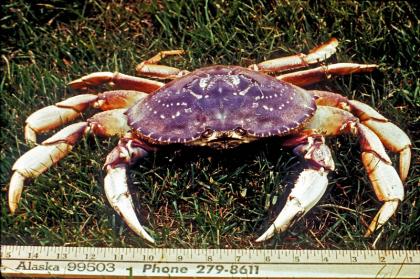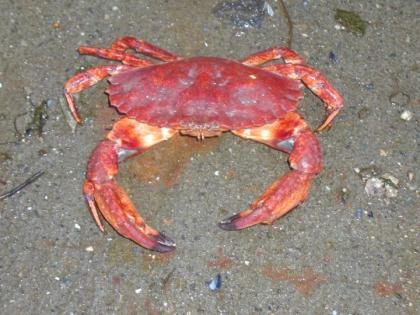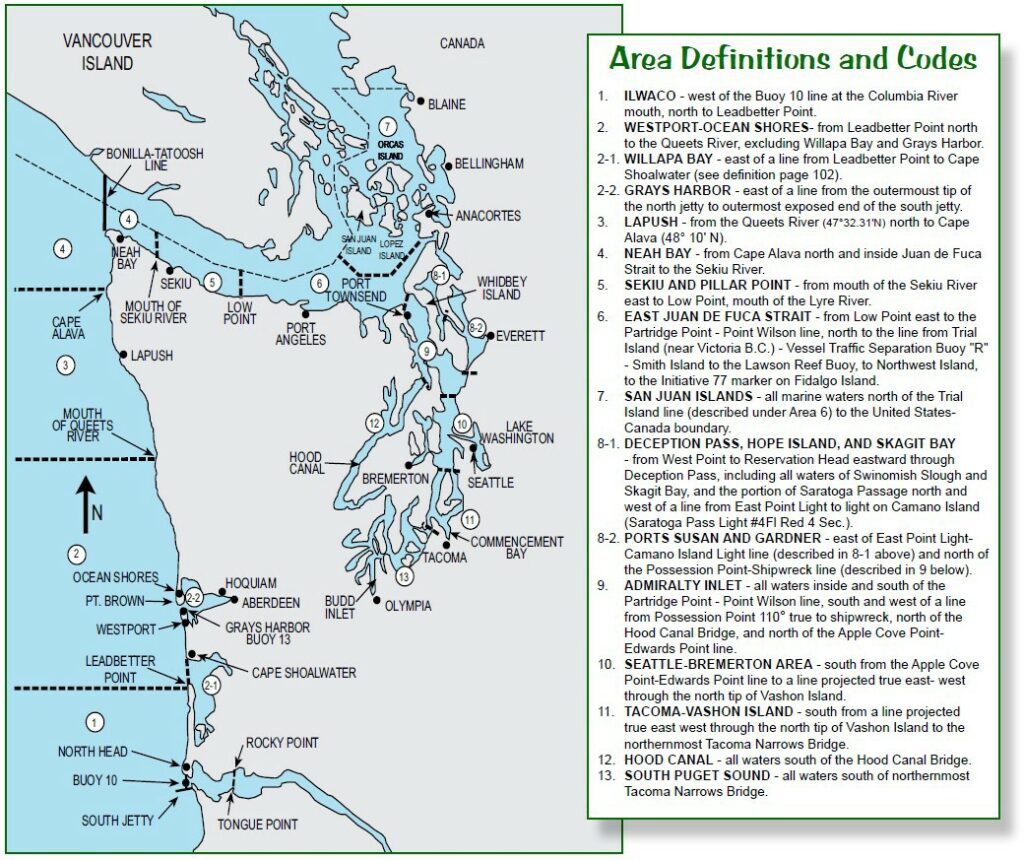Community Environment Government
State keeps South Sound closed to crabbing for sixth summer
South Sound Dungeness crab numbers remain too low to support a fishery again this summer, and possibly ever. There is, however, a ray of hope.
Washington State Fish & Wildlife announced on June 14 that when most of Puget Sound opens to recreational crabbing beginning July 1, South Sound will stay closed for the sixth straight summer. The South Sound is defined as all waters south of the Tacoma Narrows Bridge (Marine Area 13). They surround most of the Gig Harbor and Key peninsulas.
Tacoma-Vashon area will be open
North of the bridges in Marine Area 11, crabbing will be permitted on Sundays and Mondays from July 2 to Aug. 28. That includes waters off Tacoma, Vashon Island and east of Gig Harbor.
The South Sound Dungeness catch plummeted from 214,404 pounds harvested by recreational and tribal fishers in 2012 to just 8,679 pounds in 2017. There hasn’t been a season since. Despite crabbing being off limits since 2018, the Dungeness population has shown little sign of recovery.
Dungeness have always been fewer in the south end of Puget Sound. They ranged from less than 1% to 4.3% of the total harvest, said Fish & Wildlife crustacean biologist Don Velasquez. Marine Area 7 (Whidbey Island), by comparison, comprises 42 percent to 61 percent of the catch.
Preseason test fishing yields few
The department has conducted preseason test fishing since 2015, Velasquez said. Fifteen commercial pots are set for 24 hours at eight stations, for a total of 120 sets. The catch has been scant, topping out at 2.43 total crabs per set the first year.
By 2022, test numbers had dipped to 1.2 Dungeness per pot, almost all legal-sized males. Only a few small males (0.2) and almost no females (0.03) were caught. A healthy population should have plenty of males and females of all ages, Velasquez said. During an open season, only males measuring 6 ¼ inches across the back can be retained; no females.

During an open season, crabbers can only keep male Dungeness that are at least 6 1/4 inches across the back.
This year, six of the eight South Sound testing sites averaged fewer than one Dungeness per set. The Nisqually Reach station, however, attracted 7.3 per pot and Chambers Bay came in at 1.8. Locally, Wollochet Bay was 0.6 and Filucy Bay 0.0. The average for the eight stations combined was 2.0, the highest since 2015. It included just 0.02 females.
Nisqually Reach was bright spot
“There was one notable change (from past years),” Velasquez said. “One station that actually showed Dungeness crab making a bit of a reinsertion was Nisqually Reach. The rest of the stations were as bad as ever. … If we start seeing Dungeness in some of our other stations besides Nisqually, I think the state and tribes will be talking about what kind of potential Dungeness season we could have there.”
Any rebound will be difficult with so few female Dungeness remaining to produce larvae. Once they age out and die after six to nine years, there are scant youngsters to replace them.
Larvae washing south from elsewhere could help. Females hold onto their fertilized eggs until they hatch. Then the larvae are suspended in the water for about three months before they settle back to the bottom. During that time, they’re at the whim of the tide and currents and could be carried to South Sound.
“If the females are low in number and you’re depending on them, it doesn’t look good for the population,” Velasquez said. “If at least you get occasional larvae from other areas, there’s more chance of your population recovering.”
Volunteers use light traps to attract and count tiny Dungeness larvae throughout Puget Sound from late April through September. Few have been seen at the South Sound station of Zittel’s Marina north of Olympia, Velasquez said. Most are found in North Sound or the Strait of Juan de Fuca.
Over-harvesting ruled out
The extended closure allows biologists to rule out over-harvesting — removing too many adult males before they could mate — as the problem. As males reach legal size in four to five years, a whole new batch would’ve matured by now.
“There’s the recognition that harvest pressure has been taken off of that population by both state and tribal and still, six years later, we’re not feeling comfortable opening,” Velasquez said.
Environmental factors could be at play. Velasquez’s personal theory is that higher surface water temperatures during some South Sound summers are likely to be lethal to young Dungeness crabs. Other factors could be ocean acidification and pollution.
Fisheries managers have not tried to relocate crabs from other areas or use hatchery techniques to seed the area. No hatchery program exists here, though they have been used on the East Coast in an effort to boost blue crab numbers, Velasquez said.
Despite Dungeness travails, test fishing has revealed plenty of red rock crabs in South Sound. Testing this year attracted 4.5 per pot across the eight stations.
However, there has not been a red rock-only season because it could lead to repeated handling and likely death of some of the few Dungeness that remain. But the primary reason is because there’s no system to record red rock crab catches and determine a catch estimate to assure the state abides by the federal court order of a 50-50 split with the tribes, Velasquez said.
Proposals have been floated to limit red rock seasons to areas where it’s known few Dungeness live, or to allow crabbers to wade with dip nets but not use pots.
There’s still hope
The Nisqually test results create a hint of optimism.
“Because I saw a little bit of a signal in Nisqually, I do hold out that hope (of Dungeness seasons returning),” Velasquez said. “I also hope that we’ll be talking about putting some infrastructure in place to allow fishing of red rock only because I do think the South Sound will have issues being a consistent Dungeness crab harvesting area.
“Some of the locals will volunteer that it’s never been good for Dungeness, and that’s probably true. The eastern portion did have some good populations. Now we’re down to one site that seems to be OK.”
Testing indicated that Marine Area 11 north of the Tacoma Narrows Bridge holds similar numbers of Dungeness as last year. That could allow for an additional winter season from mid-November through Dec. 31, Velasquez said. A shortened winter season was held in 2022.
The season
Marine Area 4 — Neah Bay east of the Bonilla-Tatoosh line: Open July 1 through Sept. 4, Thurs.-Mon.
Marine Area 5 — Sekiu: Open July 1 through Sept. 4, Thurs.-Mon.
Marine Area 6 — East Juan de Fuca Strait: Open July 1 through Sept. 4, Thurs.-Mon.
Marine Area 7 (North) — Gulf of Georgia: Open Aug. 17 through Sept. 30, Thurs.-Mon.
Marine Area 7 (South) — San Juan Islands-Bellingham: Open July 15 through Sept. 30, Thurs.-Mon.
Marine Area 8-1 — Deception Pass: Open July 1 through Sept. 4, Thurs.-Mon.
Marine Area 8-2 — Port Susan-Everett: Open July 1 through Sept. 4, Thurs.-Mon.
Marine Area 9 — Port Gamble and Admiralty Inlet: Open July 1 through Sept. 4, Thurs.-Mon.
Marine Area 10 — Seattle-Bremerton: Open July 2 through Sept. 4, Sun.-Mon.
Marine Area 11 — Tacoma-Vashon Island: Open July 2 through Aug. 28, Sun.-Mon.
Marine Area 12 — Hood Canal north of a line true east from Ayock Point: Open July 1 through Sept. 4, Thurs.-Mon.
Marine Area 12 — Hood Canal, south of a line true east from Ayock Point: Closed
Marine Area 13 — South Puget Sound: Closed
The Rules
License — Crab fishers 15 and older must buy a recreational fishing license from WDFW.
Daily catch limit — Maximum of five hard-shelled male Dungeness crabs with carapaces at least 6 1/4 inches wide. No females. Maximum of six hard-shelled red rock crabs of either sex with carapaces at least 5 inches wide. Maximum of six hard-shelled tanner crabs of either sex with carapaces at least 4 1/2 inches wide.
Catch report card — Dungeness crab catches must be reported to WDFW online or by mailing in a catch report card by Oct. 1. Fishers who don’t send in a report card will receive a $10 penalty on their next crab license purchase. Catch cards only apply to Dungeness crabs.
Traps — One or two crab traps per person. No limit on the number of traps per boat. Traps must be pulled from one hour after official sunset to one hour before official sunrise and removed from the water on closed days.





